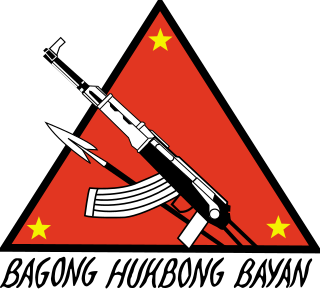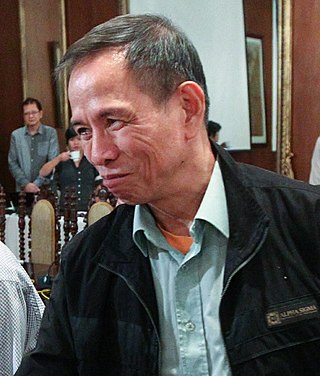Related Research Articles

The New People's Army is the armed wing of the Communist Party of the Philippines (CPP). It acts as the CPP's principal organization, aiming to consolidate political power from what it sees as the present "bourgeois reactionary puppet government" and to aid in the "people's democratic revolution". Founded on March 29, 1969, by the collaboration of Jose Maria Sison and former members of the Hukbalahap led by Bernabe Buscayno, the NPA has since waged a guerrilla war based on the Maoist strategy of protracted people's war. The NPA is one of the key figures in the ongoing communist rebellion in the Philippines, the longest ongoing conflict in the country.

The Communist Party of the Philippines is a far-left, Marxist–Leninist–Maoist revolutionary organization and communist party in the Philippines, formed by Jose Maria Sison on 26 December 1968.
Terrorism is a major social issue in the Philippines linked to the Moro conflict and the communist rebellion. The country ranks in 18th place on the Global Terrorism Index's 2023 list of countries most affected by terrorism.

The Plaza Miranda bombing occurred during a political rally of the Liberal Party at Plaza Miranda, Quiapo district, Manila, the Philippines on August 21, 1971. It caused nine deaths and injured 95 others, including many prominent Liberal Party politicians.

The New People's Army rebellion is an ongoing conflict between the government of the Philippines and the New People's Army (NPA), the armed wing of the Marxist–Leninist–Maoist Communist Party of the Philippines (CPP). It is the most prominent communist armed conflict in the Philippines, with more than 43,000 insurgency-related fatalities between 1969 and 2008. It is also one of the longest ongoing communist insurgencies in the world.
1987 in the Philippines details events of note that happened in the Philippines in the year 1987.
1988 in the Philippines details events of note that happened in the Philippines in the year 1988.

The history of communist armed conflicts in the Philippines is closely related to the history of Communism in the Philippines, with various armed conflict linked to the armed wings of the various communist organizations that have evolved since 1930. The two largest conflicts have been the Hukbalahap Rebellion of 1942–1954, and the ongoing rebellion of the New People's Army, which began in 1969 under the auspices of the Communist Party of the Philippines (CPP). But various splinter groups have since separated from the CPP and have had a history of armed conflict with the Philippine government since then.
The following is the timeline of events of CPP-NPA-NDF rebellion, a conflict between the government of the Philippines, the Communist Party of the Philippines (CPP), the New People's Army (NPA) and the National Democratic Front (NDF).
This timeline contains the events of the communist rebellion of the year 2016.
The Second Great Rectification Movement refers to a 1992 ideological campaign initiated by the leadership of the Communist Party of the Philippines (CPP) wherein an effort was made to "identify, repudiate and rectify the errors of urban insurrectionism, premature big formations of the New People's Army and anti-infiltration hysteria". The rectification movement resulted in the once monolithic Filipino communist party fragmenting into at least eight warring factions during the 1990s.

Benito Tiamzon was a Filipino political organizer and until his arrest in March 2014 by Philippine security forces, was believed to be the Chairman of the Communist Party of the Philippines (CPP) and its armed wing, the New People's Army (NPA).
In the Philippines, red-tagging is the labeling of individuals or organizations as communists, subversives, or terrorists, regardless of their actual political beliefs or affiliations. It is a type of harassment and has pernicious effects on its targets. Red-tagging has been practiced by security forces, government officials and shills.

The National Task Force to End Local Communist Armed Conflict (NTF-ELCAC) is a task force organized by the government of the Philippines in 2018 as part of its "Whole-of-Nation approach" to respond to and raise awareness about ongoing communist armed conflicts in the Philippines, after the administration of President Rodrigo Duterte formally terminated peace talks between the Philippine government and the New People's Army in November 2017.
Keith Absalon, a collegiate footballer who played for the FEU Tamaraws in the University Athletic Association of the Philippines (UAAP) and his cousin, Nolven, were killed when they ran over an explosive, reportedly a landmine or an improvised explosive device, that was set up by the New People's Army (NPA) in June 2021 in Masbate City, Philippines.

Antonio Gumba Parlade Jr. is a former Filipino military officer who retired as commander of the Armed Forces of the Philippines Southern Luzon Command in 2021, and was best known for his combative terms as spokesman for the Philippine Army before he was removed from that post in 2011, and later, as spokesperson of the National Task Force to End Local Communist Armed Conflict (NTF-ELCAC).
The Rano massacre, also known as the Digos massacre, refers to the aftermath of an incident which occurred in the village of Rano in Digos, Davao del Sur on June 25, 1989 which resulted to the death of 39 people. The New People's Army claimed responsibility for the deaths but insisted that anti-communist vigilantes among the victims fired at them first.
In August 2022, a motorboat carrying rebels of the New People's Army exploded in Catbalogan, Samar. The explosion killed the passengers including NPA leaders Benito and Wilma Tiamzon.
References
- ↑ Nepomuceno, Priam (May 17, 2021). "1,506 atrocities in 10 years justify CPP-NPA terror tag". Philippine News Agency. Retrieved February 2, 2025.
- ↑ "Fact Check | Claim that Ninoy as mastermind of Plaza Miranda bombing is historical fact is false". News5. 2022-07-11. Retrieved 2022-08-13.
- ↑ Gregg Jones (1989-08-04). "Ex-communists Party Behind Manila Bombing". The Washington Post . Washington, D.C. ISSN 0190-8286. OCLC 1330888409.
- 1 2 3 4 "Communist Party of the Philippines/New People's Army (CCP/NPA)". Counterterrorism Guide - dni.gov. September 2022. Retrieved February 2, 2025.
- ↑ Richburg, Keith B. (27 June 1989). "39 slain at church, says Manila". Washington Post. Retrieved 21 September 2021.
- ↑ "Massacre heightens NPA's bad image United Church leader says". UCA News. 4 July 1989. Retrieved 21 September 2021.
- ↑ Palicte, Che (25 June 2021). "1989 Rano massacre remembered with monument unveiling". Philippine News Agency. Retrieved 21 September 2021.
- ↑ "Communist Army Admits Massacre". The Victoria Advocate. Davao City. Associated Press. 28 June 1989. p. 6C. Retrieved 21 September 2021.
- ↑ "'Another win vs terrorism': DOJ secures conviction of key CPP-NPA member". Department of Justice - Republic of the Philippines. May 22, 2024. Retrieved February 2, 2025.
- ↑ Guadalquiver, Nanette (November 27, 2017). "NegOcc police on full alert to preempt NPA attack". Philippine News Agency. Retrieved February 2, 2025.
- ↑ Araja, Rio; Cruz, Maricel (12 June 2021). "Lawyers, rights agency weigh in on Absalon case". Manila Standard. Retrieved 22 June 2021.
- ↑ Relativo, James (7 June 2021). "CPP-NPA iniimbestigahan football player death matapos akusahan ng PNP". Pilipino Star Ngayon (in Tagalog). Retrieved 22 June 2021.
- ↑ Villanueva, Raymund (14 June 2021). "NDFP: Military blurs distinction between banned and allowable landmines". Bulatlat . Retrieved 22 June 2021.
- ↑ "CPP-NPA takes responsibility for killing of labor leader, UAAP football player in Masbate". Rappler. 8 June 2021. Retrieved 24 September 2022.
- ↑ Nepomuceno, Priam (August 14, 2023). "Nat'l Security Council scores latest NPA attack in Masbate". Philippine News Agency. Retrieved February 2, 2025.
- ↑ "Guerillas Kill Mayor In Ambush". AP NEWS. Associated Press. 28 December 1988. Retrieved 24 September 2022.
- ↑ Fowler, Glenn (22 April 1989). "Col. James Rowe, 51, War Hero, Is Killed in an Ambush in Manila". The New York Times. Retrieved 24 September 2022.
- ↑ Keith B. Richburg (1989-04-22). "U.S. ADVISOR KILLED IN MANILA". The Washington Post . Washington, D.C. ISSN 0190-8286. OCLC 1330888409.
- ↑ "Trial court orders release of NPA member convicted for death of US Army Col. Rowe". Manila Bulletin. 20 December 2021. Retrieved 24 September 2022.
- ↑ "Philippine Rebels Say They Killed U.S. Colonel". The New York Times. 23 April 1989. Retrieved 24 September 2022.
- ↑ "Philippine Rebels Kill Mayor and Threaten G.I.'s". The New York Times. 7 January 1990. Retrieved 24 September 2022.
- ↑ "Priest Turned Rebel killed by Communist Guerrillas Led by Brother". UCA News. 6 January 2000. Retrieved 3 October 2017.
- ↑ "NPA admits killing mayor over black sand mining". Philippine Daily Inquirer. 26 April 2014. Retrieved 24 September 2022.
- ↑ Romero, Alexis (7 July 2014). "NPA admits killing Bukidnon mayor". The Philippine Star. Retrieved 24 September 2022.